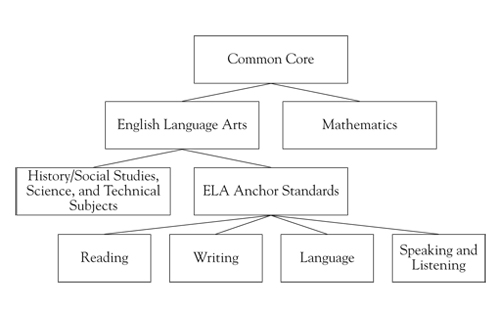Busy instrumental music teachers in the states that have adopted the Common Core State Standards (CCSS) will benefit from quick and effective ways to incorporate the standards in rehearsals while keeping the focus on music. A common-sense approach to integrating the standards will provide simple strategies for instrumental teachers to lead student musicians to an enlightened and expressive performance.
There are simple ways for students to reach musical goals using the CCSS as a guide. The following three-step process should assist instrumental music teachers when incorporating Common Core State Standards into the music curriculum.1 To begin, select one composition planned for the next concert cycle and complete a pedagogical analysis of the piece, extracting major themes from the piece such as technical elements (key center, meter, and rhythm), historical significance/ perspective, form, and vocabulary. As an example, consider Variations on a Korean Folk Song by John Barnes Chance. Pedagogical analysis revealed the following items:
• Simple and compound time
• Syncopation
• Major and pentatonic scales (Bb, Ab, Db ,Gb)
• Theme and variation
• Melodic inversion
• Rhythmic augmentation
• Polymeter
• Canon
• Korea
• The Ford Foundation Young Composers Project
When analysis is complete, identify three to five musical goals for students to achieve during the study of the selected composition. For Variations on a Korean Folk Song, I have selected four goals from three categories.
• Technical elements: simple and compound time, syncopation
• Technical elements: major and pentatonic scales
• Historical perspective: Ford Foundation Young Composers Project
• Form: theme and variations (folksongs)
The final step is to study the CCSS Anchor Standards (ELA) and develop student activities that will accomplish your musical goals for students and meet the standards.
One of the Anchor Standards for Writing [CCSS.ELA-LITERACY. CCRA.W.7] states that students should “conduct short as well as more sustained research projects based on focused questions, demonstrating understanding of the subject under investigation.” Instrumental music teachers can integrate this standard by asking students to answer focused questions about Variations on a Korean Folk Song. Students should compose the answers outside of class, with the option to submit them either on paper or electronically. Sample writing prompts that address the musical goals identified above might include:
• Do you like music in simple or compound time? Why?
• Describe syncopation in your own words.
• List four possible ways in which composers vary a theme in music (Theme and Variation form).
• What is your favorite American folk song? Why?
• What is a major scale, and how is it constructed?
• What is a pentatonic scale, and how is it constructed?
Another Anchor Standard for Writing [CCSS.ELA-LITERACY. CCRA.W.10] states that students should “write routinely over extended time frames (time for research, reflection, and revision) and shorter time frames (a single sitting or a day or two) for a range of tasks, purposes, and audiences.” Teachers can provide creative writing prompts that can be answered by the students in one sitting, or develop more complex questions that require extended time (perhaps a week or two). To accomplish the musical goal on the Ford Foundation Young Composers Project, I would ask students to produce an essay that describes what it might be like to have the composer in the classroom each day during the school year, as John Barnes Chance was at Greensboro High School. Possible ideas to include in the essay would be what students might ask the composer about his music, what they might ask the composer to change, and what kind of music they would want an in-residence composer to write for their group.
An Anchor Standard for Reading [CCSS.ELA-LITERACY.CCRA.R.1] asks that students “read closely to determine what the text says explicitly and to make logical inferences from it.” A second Reading Standard [CCSS.ELA-LITERACY.CCRA.R.10] states that students should “read and comprehend complex literary and informational text independently and proficiently.” Another way to achieve the historical perspective goal is to ask students to read a short historical account of the Young Composers Project. Additionally, students could read biographical information about the composer. Students may write a short response or summary about the assigned readings.
One of the Anchor Standards for Speaking and Listening [CCSS.ELA-LITERACY.CCRA.SL.4] states that students should “present information, findings, and supportive evidence such that listeners can follow the line of reasoning.” To reach the musical goal of having students study theme and variations form, teachers can design a listening project that results in students presenting their findings to the class – or to the audience at the concert. Guided listening activities for Variations on a Korean Folk Song might ask students to find the melody in each variation, identify the instruments that play it, and then present those findings. Another listening activity might ask students to identify each variation as simple or compound time; this has the added bonus of connecting to one of the other musical goals I established.
Directors often lament that adding more to their already overflowing plate means that they will have to reduce the amount of music they prepare for the next concert. While that might be the case, it should be noted that most of the activities above could be completed outside of the classroom. Rehearsal time is a cherished resource; teachers should use only what class time is needed to guide student activities and then allow the students to complete the work on their own time.
Common Core Basics for Music Teachers
Designed by National Governors Association and the Council of Chief State School Officers, the Common Core State Standards (CCSS) are designed to prepare students for entry-level careers, freshman-level college coursework, and workforce training programs. With high-stakes testing still at the forefront of education, it has become imperative that teachers in all disciplines understand and authentically integrate the standards in their classrooms.2
The CCSS are organized into two areas: English Language Arts (ELA) and Mathematics. Within the ELA category, the standards are further divided into Literacy in History/Social Studies, Science, and Technical Subjects, which are specific by discipline and grade level, and College and Career Readiness Anchor Standards, which are broad and reach across multiple grade levels. The broadness of the Anchor Standards make them a natural fit for instrumental music educators, who typically instruct multi-grade classrooms. The ELA Anchor Standards are divided into reading (ten standards, writing (ten standards), speaking and listening (six standards), and language (six standards).

Endnotes
1 Integrating the Common Core Standards into the Music Classroom by Tom Foust (Illinois Music Educators Association Conference, 2013).
2 Common Core State Standards (www.corestandards.org).






